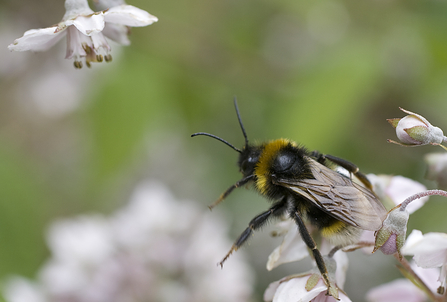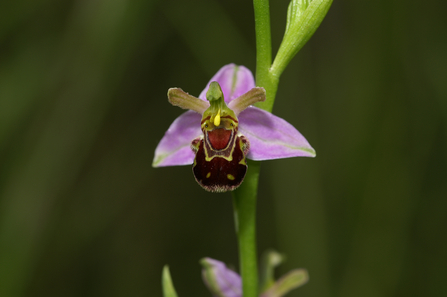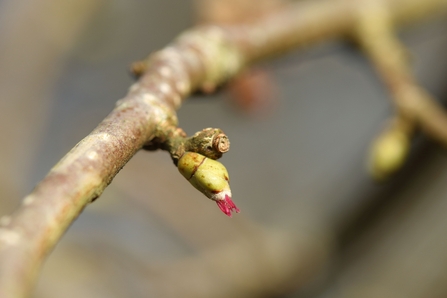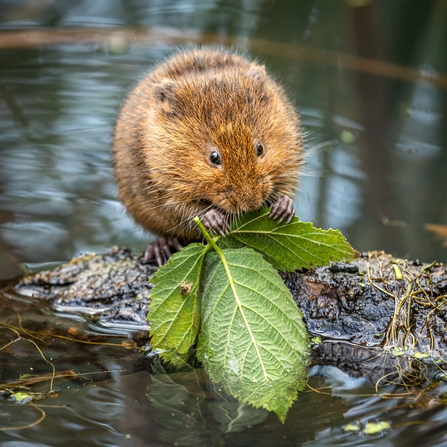At the Trust, we are all about celebrating the wonder and idiosyncrasies of our natural world. In the pursuit to survive, populate, eat and not be eaten, our wildlife has evolved fascinating strategies – these five females of the species are a case in point. Read on to discover more, we’re sure you’ll be amazed!
Five Females of the Species and their Feminine Wiles in Nature
Bee Orchid (c) Alan Price

Vestal Cuckoo Bee (c) Penny Frith
Vestal Cuckoo Bee
The Vestal Cuckoo Bee isn’t all that it seems. It is the Buff-tailed Bumblebee’s doppelgänger and it has evolved similar features so that females can sneak into the nests of their close cousins and lay their own eggs. Once inside, the Vestal Cuckoo Bee takes on the nest scent so she isn’t attacked as an intruder. Then, she dominates or kills the host queen before laying her own eggs, which the Buff-tailed Bumblebee colony cares for as if they were their own.

Bee Orchid (c) Tom Day
Bee Orchid
This delightful flower is a true wonder of nature. The bulbous velvety lip at the bottom of the flower loosely resembles a female bee, complete with stripes and even a thin coating of fur. A most deceiving plant, Bee Orchids also emit a female bee scent to lure male Long-horned Bees with mating on their mind. As they land on the lip, pollen is transferred, thus pollinating the plant but leaving the poor male bee frustrated. There were two species of Long-horned Bees in the UK (Eucera longicornis and Eucera nigrescens), the former is mainly found in localised populations in Southern England and Southern Wales but, sadly, the other is now thought to be extinct here. Bee Orchids are still found without the bees and are able to self-pollinate – look out for them at our Hexton Chalk Pit Nature Reserve, in the village of Hexton, to the west of Hitchin.

Nursery Web Spider (c) Josh Kubale
Nursery Web Spider
The Nursery Web Spider is commonly found in grassland scrub and can often be found sunbathing among Brambles and Stinging Nettles. The female will carry her round egg-sac in her fangs and when her young are about to hatch, she’ll build a silk sheet amongst the vegetation to act as a tent, sheltering them until they are old enough to make their own way into the world.

Hazel flowers (c) Vaughn Matthews
Hazel
The Hazel is monoecious, meaning that it has separate male and female parts on the same tree. Whilst the male catkins make quite a show, the much smaller and more discreet female flower bud has several flowers with protruding crimson stigmas. The female bud sits above the male flower so as not to self-pollinate but to instead catch wind-blown pollen. Once fertilised the female flower develops into an oval fruit, which hang in groups of one to four and mature into a nut with a woody shell, known as a cob.

Water Vole at Thorley Wash (c) Sophia Spurgin
Water Vole
Water Voles breed rapidly and typically produce three or four litters a year with up to five pups at a time. The average lifespan of a Water Vole being six to 18 months, it is possible that a female might deliver 30 pups in her lifetime!
Over to you!
- Seek out more fantastic female facts by studying the Wildlife Explorer pages of our website here.
- Support the Vestal Cuckoo Bees and Buff-tailed Bumblebees mentioned in this article, plus the other 270+ bee species found in the UK, by taking action and signing The Wildlife Trusts’ ‘Say No to Neonics’ petition to stop the use of these bee-killing pesticides and to encourage wildlife-friendly farming. Thank you!

